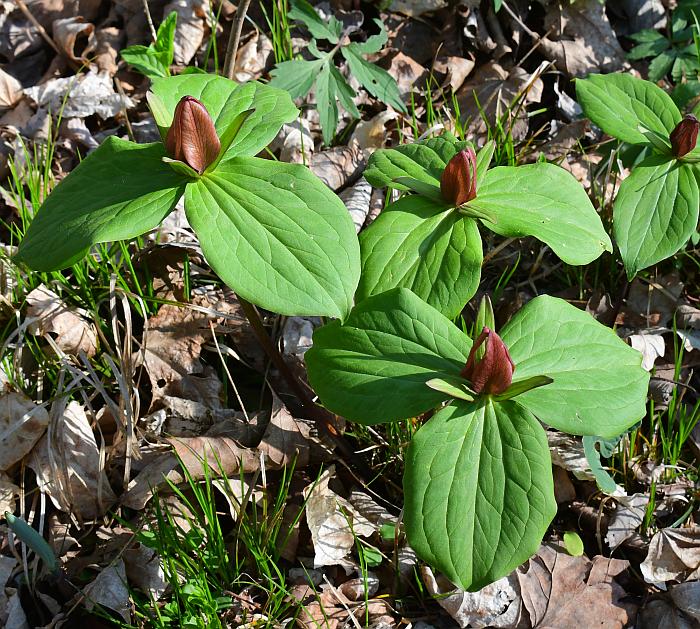Trillium sessile L.
Wake Robin

Native
CC = 5
CW = 5
MOC = 62
© SRTurner
Trillium sessile L.Wake Robin | |
 |
Native CC = 5 CW = 5 MOC = 62 |
© SRTurner |
|
Family - Liliaceae Habit - Perennial forb from short rhizomes. Stems - Erect, to 30 cm, purplish (at least at base), glabrous. Leaves - Whorled, 3 per plant, sessile, 5-9 cm long, usually about 2 times longer than wide, broadly elliptic to broadly ovate, the tips usually rounded, glabrous, usually not or only slightly mottled, the upper surface lacking stomates or with only a few near the tip, entire.
Inflorescence - Single sessile flower terminating the aerial stem. Flowers - Erect, sessile. Sepals 3, spreading to ascending at flowering, 20-25 mm long, lanceolate to narrowly ovate, sometimes purplish tinged. Petals 3, 15-36 mm long, erect or nearly so, lanceolate to narrowly elliptic, broadest at or below the middle, narrowed at the base but the stalklike portion absent or less than 2 mm long, usually maroon, glabrous, erect. Stamens 6, 12-20 mm long, half or more than half as long as the petals. Filaments purple, 2-3mm long. Anthers long, yellow-brown. Ovary superior, 3-locular, with 6 angles or wings.
Fruits - Erect berries. Flowering - April - June. Habitat - Mesic and bottomland forests on lower slopes and bottoms of valleys and ravines. Origin - Native to the U.S. Lookalikes - Other species of trillium, especially T. viride, T. viridescens, and T. recurvatum. Other info. - This fine species can be found mainly in the lower 2/3 of Missouri. The plant is fairly common in the habitats mentioned above. In appearance it is quite similar to its lookalikes, but can be distinguished by sepals which are spreading (not reflexed), petals which are usually deep reddish and broadest below the middle, and stamens that are at least half as long as the petals. Photographs taken at Eagle Bluffs Conservation Area, Boone County, MO., 3-27-04, and at Rock Hill Park, Columbia, MO., 4-18-04 (DETenaglia); also at Bootleg Access, Washington County, MO, 4-7-2020 and 4-6-2021 (SRTurner). |